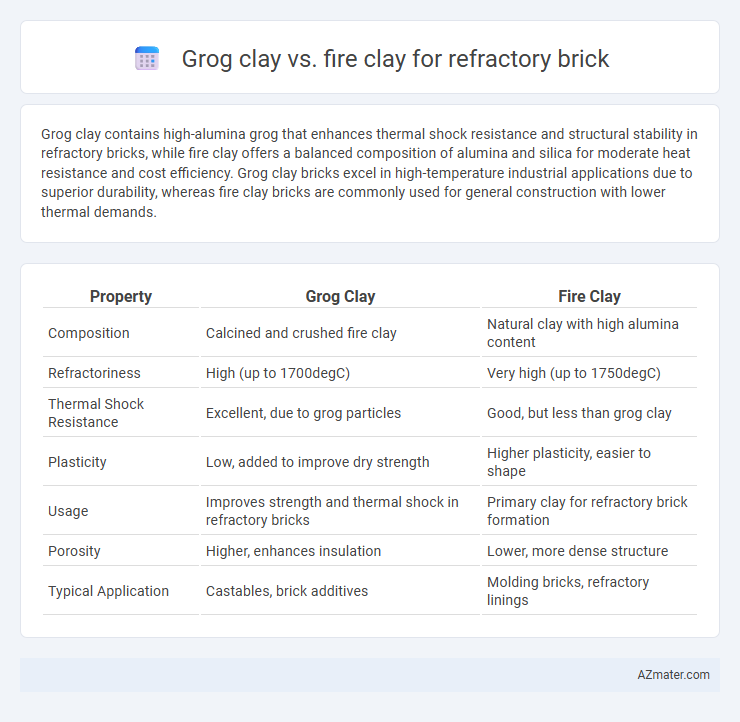Grog clay contains high-alumina grog that enhances thermal shock resistance and structural stability in refractory bricks, while fire clay offers a balanced composition of alumina and silica for moderate heat resistance and cost efficiency. Grog clay bricks excel in high-temperature industrial applications due to superior durability, whereas fire clay bricks are commonly used for general construction with lower thermal demands.
Table of Comparison
| Property | Grog Clay | Fire Clay |
|---|---|---|
| Composition | Calcined and crushed fire clay | Natural clay with high alumina content |
| Refractoriness | High (up to 1700degC) | Very high (up to 1750degC) |
| Thermal Shock Resistance | Excellent, due to grog particles | Good, but less than grog clay |
| Plasticity | Low, added to improve dry strength | Higher plasticity, easier to shape |
| Usage | Improves strength and thermal shock in refractory bricks | Primary clay for refractory brick formation |
| Porosity | Higher, enhances insulation | Lower, more dense structure |
| Typical Application | Castables, brick additives | Molding bricks, refractory linings |
Introduction to Refractory Bricks
Refractory bricks are specialized ceramic materials designed to withstand high temperatures and thermal shock in industrial furnaces and kilns. Grog clay, made by crushing and calcining natural fire clay, enhances thermal stability and reduces shrinkage, whereas fire clay consists of naturally occurring clay minerals known for their alumina content and refractory properties. The choice between grog clay and fire clay in refractory bricks directly impacts durability, thermal conductivity, and resistance to chemical corrosion in high-temperature environments.
What is Grog Clay?
Grog clay is crushed, fired clay added to refractory brick mixtures to enhance thermal shock resistance and reduce shrinkage during high-temperature exposure. Unlike fire clay, which is naturally occurring and rich in alumina and silica, grog clay consists primarily of pre-fired, ground ceramic material used as an aggregate to improve brick durability. This inclusion increases brick stability under extreme heat, making grog clay essential for applications requiring enhanced mechanical strength and thermal resilience in refractory bricks.
What is Fire Clay?
Fire clay is a type of refractory material composed primarily of kaolinite and alumina, known for its high melting point and excellent thermal stability, making it ideal for manufacturing refractory bricks used in high-temperature environments. Grog clay contains pre-fired refractory material ground into granules that enhance the brick's strength and reduce shrinkage by improving thermal shock resistance. Fire clay bricks are favored for their ability to withstand prolonged exposure to heat without deforming, whereas grog clay boosts mechanical durability and dimensional stability in refractory applications.
Key Properties: Grog Clay vs Fire Clay
Grog clay contains pre-fired ceramic particles that enhance thermal shock resistance and reduce shrinkage in refractory bricks, making it ideal for high-temperature industrial applications. Fire clay has a high alumina content and excellent plasticity, providing strong resistance to heat and chemical corrosion while maintaining structural integrity. Both materials contribute to refractory bricks' durability, but grog clay excels in thermal stability, whereas fire clay offers superior plasticity and refractory strength.
Thermal Resistance Comparison
Grog clay exhibits higher thermal shock resistance and can withstand rapid temperature fluctuations up to 1600degC, making it ideal for industrial kilns requiring durability. Fire clay bricks demonstrate excellent thermal stability with a slightly higher melting point around 1750degC, providing superior resistance under prolonged high-temperature exposure. Both materials offer robust refractory properties, but grog clay is preferred for thermal shock applications while fire clay excels in steady high-heat environments.
Mechanical Strength Differences
Grog clay contains pre-fired, crushed particles that enhance the mechanical strength of refractory bricks by improving thermal shock resistance and reducing shrinkage during firing, which leads to higher durability under mechanical stress. Fire clay, composed primarily of kaolinite, offers excellent plasticity and high refractoriness but generally exhibits lower mechanical strength compared to grog clay due to greater shrinkage and potential cracking. Choosing grog clay for refractory bricks results in superior mechanical performance in high-temperature environments where resistance to abrasion and deformation is critical.
Workability and Shaping Considerations
Grog clay contains pre-fired grog particles that improve workability by reducing shrinkage and enhancing drying stability, making it easier to shape complex refractory bricks without cracking. Fire clay lacks these refractory grog inclusions, leading to higher plasticity but increased risk of deformation and shrinkage during drying and firing. Therefore, grog clay is preferred for applications requiring precise shaping and dimensional stability in refractory brick manufacturing.
Cost and Availability
Grog clay is generally more affordable and widely available compared to fire clay, making it a cost-effective choice for refractory bricks in many industrial applications. Fire clay, while typically more expensive, offers superior heat resistance and durability, which justifies its higher price in high-temperature environments. Availability of grog clay is higher due to its abundance in various geographic regions, whereas fire clay supply may be limited and subject to regional mining constraints.
Best Applications for Each Clay Type
Grog clay, composed of crushed firebrick or refractory material, enhances thermal shock resistance making it ideal for kiln linings, furnaces, and high-wear environments requiring durability under rapid temperature changes. Fire clay, rich in alumina and silica, offers excellent heat retention and chemical stability best suited for applications like combustion chambers, boilers, and refractory castables where sustained high temperatures are common. Choosing between grog clay and fire clay depends on operational demands: grog clay excels in abrasion resistance and thermal cycling, while fire clay is preferred for insulation and prolonged heat exposure.
Conclusion: Choosing the Right Clay for Refractory Bricks
Grog clay offers superior thermal shock resistance and dimensional stability, making it ideal for high-temperature applications where durability is critical. Fire clay provides excellent refractoriness and chemical resistance, suited for environments exposed to intense heat and corrosive materials. Selecting the right clay depends on the specific operational demands, with grog clay preferred for mechanical strength and fire clay for high-temperature thermal insulation.

Infographic: Grog clay vs Fire clay for Refractory brick
 azmater.com
azmater.com